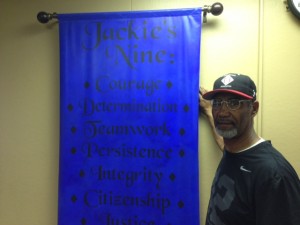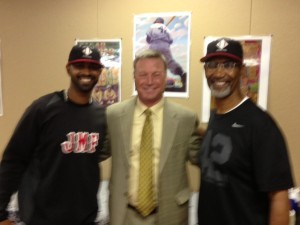On April 15, Jackie Robinson Day, every Major League Baseball player will wear a jersey sporting the number 42, to honor the player who broke the color barrier back in 1947. The movie “42” is now on the big screen and it’s already a big hit with baseball fans — and movie fans everywhere. In fact, early box office receipts show “42” had the highest grossing weekend debut of any baseball film ever.
But Jackie Robinson would be disappointed to see how few African American players are in the game today. Baseball is of course, a game of numbers and the numbers show African Americans comprised just 8.5% of all players on Opening Day rosters this year. The numbers used to be double that in the 1980’s. In fact, nearly one out every five ballplayers was African American in 1986 (19% to be exact), according to the Society for American Baseball Research. And yet ironically in 2013, the World Champion San Francisco Giants do not have one black player on their roster. Ten teams have no more than one African American player.
So what has happened to Jackie Robinson’s legacy? To help answer that question, I interviewed former baseball manager Jerry Manuel in Elverta, California, where he runs the Jerry Manuel Foundation which is dedicated to bringing more African American kids into the great game of baseball. Manuel managed the Chicago White Sox from 1998 – 2003 and the New York Mets from 2008 – 2010. Major League Baseball Commissioner Bud Selig just selected Manuel to a task force designed to increase diversity — and especially the number of African Americans in the game.
Manuel and his son Anthony have teamed up to educate several dozen African American kids at Alpha Middle School in Elverta — where they also learn the fundamentals of baseball, using Jackie Robinson’s values of integrity, commitment and persistence as their guide.
Jerry and Anthony recently took ten of their kids to the premier of “42” is Los Angeles. Jerry told me the students are wide-eyed and filled with questions. “Yes they were very surprised,” he said. “There were still questions, ‘Were there really different drinking fountains? Were there really different bathrooms?'”
Then Manuel addressed the anemic modern-day numbers of African American ballplayers. “We have dropped the ball,” Manuel stated. “My generation has pretty much dropped the ball in promoting this great game of baseball. Our culture has given so much to the game. Willie Mays, Hank Aaron, Frank Robinson…” Manuel said as his voice trailed off.
I asked him why Jackie’s legacy has faded so fast.
“We really haven’t had that one athlete that transcends the sport like LeBron transcends basketball,” he told me. “All our youth identify with LeBron. We’re trying to identify that athlete, say a Matt Kemp, CC Sabathia, Torii Hunter, Curtis Granderson, even Derrek Lee here in Sacramento, to get them to understand that these guys played the game of baseball and they can help you to have longevity in this beautiful game.”
Another key factor is the cost of playing baseball. It’s expensive to buy bats, mitts, balls and baseball cleats. Plus, you need a wide open grassy space to play ball. By contrast, to play basketball, all you need is a hoop and a pair of sneakers. You can even sharpen your skills by yourself against a backboard, whereas baseball requires at least two to have a catch.
“All the sports now, kids are choosing early what they’re going to do,” Manuel explained. “When I came about it was three sports. You played baseball, you played basketball, you played football. Now they’re choosing the one sport.”
Jackie Robinson played four sports at UCLA, where he excelled in baseball, basketball, football and track in 1939 and 1940. Ironically, Robinson considered baseball to be his “worst” sport. Also attending UCLA at that time was my cousin Hal Auerbach, who grew up in Michigan with my dad. They remained close friends throughout their lives.
But back to baseball, where Jerry Manuel explained that the great expense of travel ball is prohibitive for many inner city kids. Major League Baseball is trying to address that with a program called RBI, which in this case stands for Reviving Baseball in the Inner cities.
But the game of baseball has changed. It’s become an international game, with roughly 30% of all players hailing from foreign lands — Japan, Korea, and the baseball hot bed of Latin America, where players from the Dominican Republic and Venezuela now dominate MLB. In fact, today’s SF Giants roster consists of six players from Venezuela, six from the Dominican Republic and one from Puerto Rico.
“Is Major League Baseball deliberately recruiting Latin American kids because it’s cheaper than recruiting inner city American kids?” I asked Manuel.
“No I don’t think so,” he said. “Well at the beginning, yes. But as you play with the basic agreement, regardless of who you are, it depends on how many years you have, but you’re going to get paid X amount of dollars.”
It’s also possible the fields are not exactly level. Latin American players can sign with major league clubs at age 15, whereas American kids must wait until 17 or 18, when their class graduates from high school. Scouts say that can put American kids at a competitive disadvantage when it comes to developing their skills at the baseball academies established by the big leagues.
Anthony Manuel cited another big reason today’s rosters are so devoid of African American players. “I think other sports target the inner city a little more,” he said. “You see more African Americans in the NFL, in the NBA. Major League Baseball is not something that the kids really look forward to. A lot of our kids are very athletic and sometime baseball can be a slower game, standing around and it’s more mental. So they’re not always able to use their tools.” he stated.
“It also goes to colleges. There are not as many scholarships for baseball. I think it’s only about 11% right now in the NCAA, when other sports can give full rides to basketball and football players,” Anthony Manuel said.
The Jerry Manuel Foundation is dedicated to changing the face of Major League Baseball. “The Jackie Robinson movie drives home what needs to be done,” Jerry Manuel told me.
“That’s what we’re all about. We’re trying to bring the kids in, teach them baseball,” Manuel said. “It’s baseball year round. And then at the same time, send them back to their Little League programs to enhance the Little League programs around Sacramento. What I’m hoping is that Major League Baseball adopts this program and then we can replicate it throughout the country. But what they’re going to be adopting, they’re not going to be adopting just the Jerry Manuel Foundation, they’re going to be adopting Sacramento. Because we’re going to go and try and fix up the fields, do everything we can to bring the kids out and play baseball.”
And watching those kids succeed would be a fitting tribute to Jackie Robinson’s legacy.


